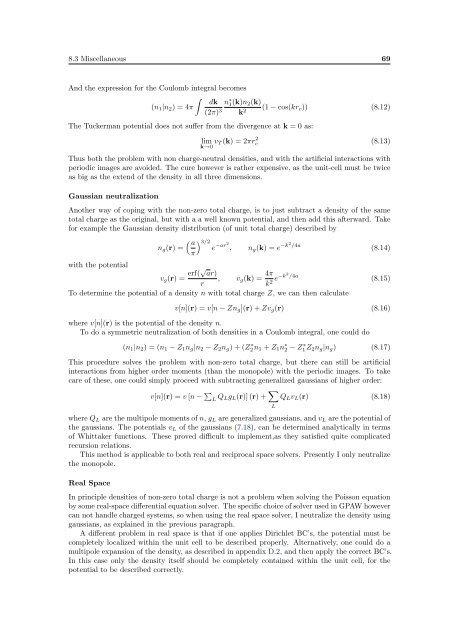Exact Exchange in Density Functional Calculations
Exact Exchange in Density Functional Calculations
Exact Exchange in Density Functional Calculations
Create successful ePaper yourself
Turn your PDF publications into a flip-book with our unique Google optimized e-Paper software.
8.3 Miscellaneous 69And the expression for the Coulomb <strong>in</strong>tegral becomes∫dk n ∗(n 1 |n 2 ) = 4π1(k)n 2 (k)(2π) 3 k 2 (1 − cos(kr c )) (8.12)The Tuckerman potential does not suffer from the divergence at k = 0 as:lim v T (k) = 2πrc 2 (8.13)k→0Thus both the problem with non charge-neutral densities, and with the artificial <strong>in</strong>teractions withperiodic images are avoided. The cure however is rather expensive, as the unit-cell must be twiceas big as the extend of the density <strong>in</strong> all three dimensions.Gaussian neutralizationAnother way of cop<strong>in</strong>g with the non-zero total charge, is to just subtract a density of the sametotal charge as the orig<strong>in</strong>al, but with a a well known potential, and then add this afterward. Takefor example the Gaussian density distribution (of unit total charge) described by( a) 3/2n g (r) = e−ar 2 ,πn g (k) = e −k2 /4awith the potentialv g (r) = erf(√ ar),rv g (k) = 4π /4ak 2 e−k2To determ<strong>in</strong>e the potential of a density n with total charge Z, we can then calculate(8.14)(8.15)v[n](r) = v[n − Zn g ](r) + Zv g (r) (8.16)where v[n](r) is the potential of the density n.To do a symmetric neutralization of both densities <strong>in</strong> a Coulomb <strong>in</strong>tegral, one could do(n 1 |n 2 ) = (n 1 − Z 1 n g |n 2 − Z 2 n g ) + (Z ∗ 2 n 1 + Z 1 n ∗ 2 − Z ∗ 1 Z 2 n g |n g ) (8.17)This procedure solves the problem with non-zero total charge, but there can still be artificial<strong>in</strong>teractions from higher order moments (than the monopole) with the periodic images. To takecare of these, one could simply proceed with subtract<strong>in</strong>g generalized gaussians of higher order:v[n](r) = v [n − ∑ L Q Lg L (r)] (r) + ∑ LQ L v L (r) (8.18)where Q L are the multipole moments of n, g L are generalized gaussians, and v L are the potential ofthe gaussians. The potentials v L of the gaussians (7.18), can be determ<strong>in</strong>ed analytically <strong>in</strong> termsof Whittaker functions. These proved difficult to implement,as they satisfied quite complicatedrecursion relations.This method is applicable to both real and reciprocal space solvers. Presently I only neutralizethe monopole.Real SpaceIn pr<strong>in</strong>ciple densities of non-zero total charge is not a problem when solv<strong>in</strong>g the Poisson equationby some real-space differential equation solver. The specific choice of solver used <strong>in</strong> GPAW howevercan not handle charged systems, so when us<strong>in</strong>g the real space solver, I neutralize the density us<strong>in</strong>ggaussians, as expla<strong>in</strong>ed <strong>in</strong> the previous paragraph.A different problem <strong>in</strong> real space is that if one applies Dirichlet BC’s, the potential must becompletely localized with<strong>in</strong> the unit cell to be described properly. Alternatively, one could do amultipole expansion of the density, as described <strong>in</strong> appendix D.2, and then apply the correct BC’s.In this case only the density itself should be completely conta<strong>in</strong>ed with<strong>in</strong> the unit cell, for thepotential to be described correctly.












